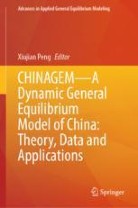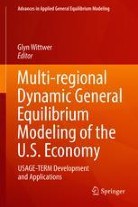
About this book series
This series has a companion series in SpringerBriefs in Applied General Equilibrium Modeling.
The series publishes advances in the theory, application, parameterisation and computation of applied general equilibrium (AGE) models. AGE analysis is now an essential input in many countries to the discussion of a wide range of economic topics relevant to public policy. This reflects the capacity of AGE models to carry extensive economic detail, their flexibility in accommodating new policy-relevant theory and data, and their capacity to project economic outcomes for a large number of macroeconomic and microeconomic variables.
Topics in AGE modeling addressed by the series include: macroeconomic forecasting and adjustment; public finance; economic growth; monetary policy and financial markets; environmental policy; energy policy; income distribution and inequality; global modeling; country-specific modeling; regional modeling; economic effects of natural disasters and other catastrophic events; productivity; demography; foreign direct investment; economic development; model solution algorithms and software; and topics in estimation, calibration and validation.
AGE applications are increasingly multi-disciplinary, spanning inputs from such diverse fields as engineering, behavioral psychology, energy modeling, land use modeling, demography, and climate modeling. The series allows for the comprehensive documentation and careful exposition of not only the AGE models themselves, but also the inter-disciplinary inputs to the modeling, and the interactions between each.
For AGE modelers, the series provides a format supporting: clear exposition of data work, attention to the theoretical modeling of relevant policy detail, and thorough discussion of simulation results. This aids both academic and policy readerships.
Academic readers will appreciate: the capacity to see details of the full complexity of relevant components of model equation systems; comprehensive documentation of data manipulation algorithms; supporting analysis and discussion of model input and closure assumptions; and careful discussion of results grounded in AGE theory, data and closure assumptions.
Policy readers will appreciate: a format that supports the reporting of the comprehensive set of model outputs of interest to policy makers; discussion of elements of the theory and data that exert a heavy influence on research findings; and nuanced and qualified discussion of the policy implications of AGE research.
The series publishes advances in the theory, application, parameterisation and computation of applied general equilibrium (AGE) models. AGE analysis is now an essential input in many countries to the discussion of a wide range of economic topics relevant to public policy. This reflects the capacity of AGE models to carry extensive economic detail, their flexibility in accommodating new policy-relevant theory and data, and their capacity to project economic outcomes for a large number of macroeconomic and microeconomic variables.
Topics in AGE modeling addressed by the series include: macroeconomic forecasting and adjustment; public finance; economic growth; monetary policy and financial markets; environmental policy; energy policy; income distribution and inequality; global modeling; country-specific modeling; regional modeling; economic effects of natural disasters and other catastrophic events; productivity; demography; foreign direct investment; economic development; model solution algorithms and software; and topics in estimation, calibration and validation.
AGE applications are increasingly multi-disciplinary, spanning inputs from such diverse fields as engineering, behavioral psychology, energy modeling, land use modeling, demography, and climate modeling. The series allows for the comprehensive documentation and careful exposition of not only the AGE models themselves, but also the inter-disciplinary inputs to the modeling, and the interactions between each.
For AGE modelers, the series provides a format supporting: clear exposition of data work, attention to the theoretical modeling of relevant policy detail, and thorough discussion of simulation results. This aids both academic and policy readerships.
Academic readers will appreciate: the capacity to see details of the full complexity of relevant components of model equation systems; comprehensive documentation of data manipulation algorithms; supporting analysis and discussion of model input and closure assumptions; and careful discussion of results grounded in AGE theory, data and closure assumptions.
Policy readers will appreciate: a format that supports the reporting of the comprehensive set of model outputs of interest to policy makers; discussion of elements of the theory and data that exert a heavy influence on research findings; and nuanced and qualified discussion of the policy implications of AGE research.
- Electronic ISSN
- 2520-8276
- Print ISSN
- 2520-8268
- Series Editor
-
- James Giesecke,
- Peter B. Dixon,
- Robert Koopman
Book titles in this series
-

-
Economy-Wide Modeling of Water at Regional and Global Scales
- Editors:
-
- Glyn Wittwer
- Copyright: 2019
Available Renditions
- Hard cover
- eBook

-
Trade Theory in Computable General Equilibrium Models
Armington, Krugman and Melitz
- Authors:
-
- Peter B. Dixon
- Michael Jerie
- Maureen T. Rimmer
- Copyright: 2018
Available Renditions
- Hard cover ( Book w. online files / update )
- Soft cover
- eBook

-
Multi-regional Dynamic General Equilibrium Modeling of the U.S. Economy
USAGE-TERM Development and Applications
- Editors:
-
- Glyn Wittwer
- Copyright: 2017
Available Renditions
- Hard cover
- Soft cover
- eBook

Publish with us
Download book proposal form
